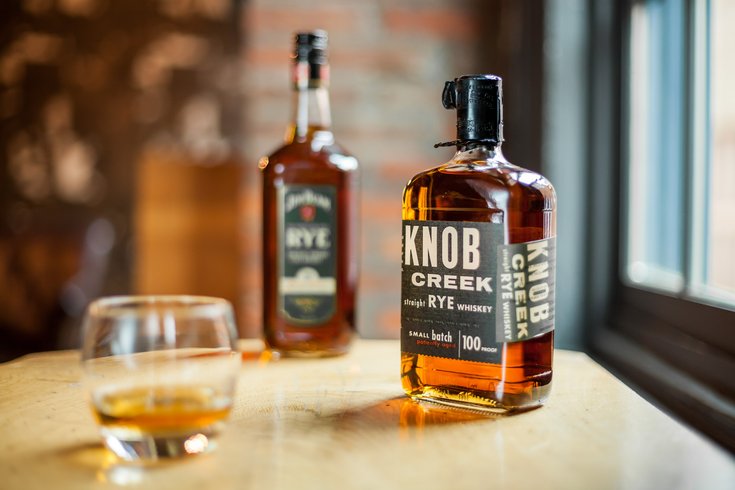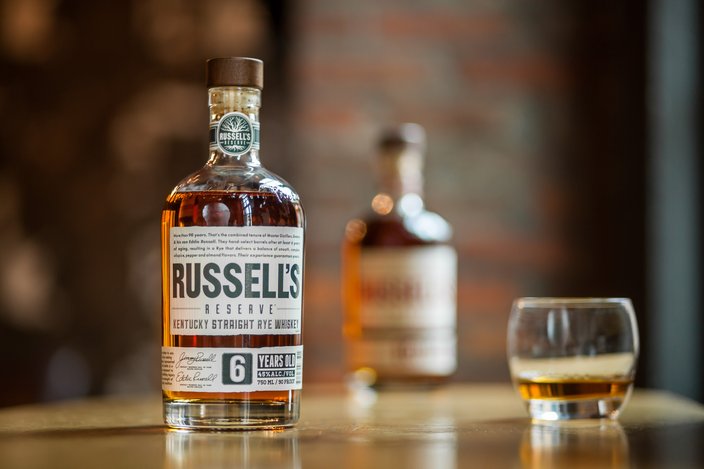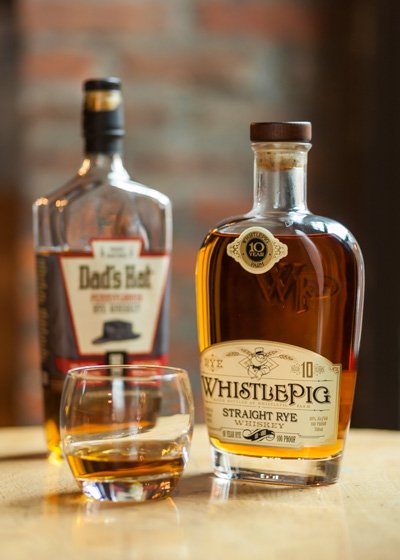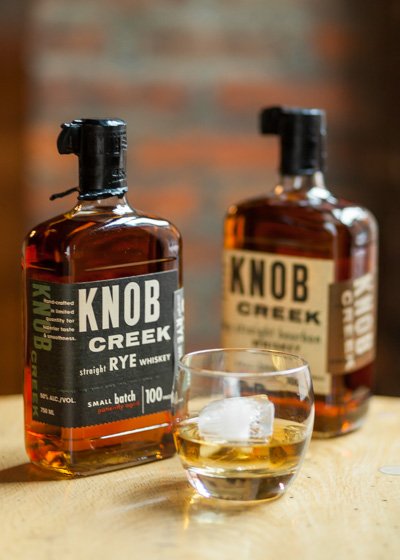
May 11, 2016
 Thom Carroll/PhillyVoice
Thom Carroll/PhillyVoice
Knob Creek Rye and Jim Beam Rye are from the same distiller but are marketed differently, according to George Reilly, owner of The Twisted Tail, a whiskey-oriented bar in Society Hill.
You know the rap all you wanna-be whiskey-swilling hipsters: rye whiskey is spicy, bourbon sweet.
Which means Manhattans are supposed to be best with rye, an Old Fashioned better made with bourbon.
Except for one critical thing: When it comes to classic American whiskies, most of you can’t tell your rye from your bourbon in a blind recognition test.
Don’t blame PhillyVoice for this cold hard truth, brown liquor lovers: Jacob Lahne earned his master’s degree in food science figuring this out before landing a professorship at Drexel University’s Center for Hospitality and Sport Management.
Now holder of a doctorate in animal, nutrition and food sciences, Lahne’s project was recently published in the Journal of Food Science.
You can read it here, but trust us, it’s full of graphs and tables and other boring stuff that leads to a master’s degree, but not much that’s fun or even very conversational.
 Thom Carroll/PhillyVoice
Thom Carroll/PhillyVoiceRussell's Reserve rye and Russell's Reserve bourbon whiskey.
So here are the important takeaways:
Asked to sort 10 blind-poured whiskeys – five bourbons and five ryes in the lower-to-mid-market price range – and asked to differentiate them solely by sniffing (see, no real fun here, though Lahne plans on repeating the test with actual tasting of the booze), average consumers could not discern a difference.
Lahne’s testing did not include Canadian whiskey, which tends toward being rye-based. But Canada has a different labeling standard, making it difficult to sort things out and compare.
Lahne said there’s a good reason for the lack of discernment between bourbon and rye: As little as 2 percent of the grain ingredients – known as the mash bill – can separate a rye from a bourbon. Barley and wheat are also smaller grain components used in some – but not all – recipes.
Rye, the original American whiskey of the colonies, and the most expensive of the grains, is at least 51 percent rye, while bourbon is at least 51 percent corn.
Mass-produced “bourbon and rye overlap in many ways, though craft whiskies less so,” said Lahne.
 Thom Carroll/PhillyVoice
Thom Carroll/PhillyVoiceWhistlePig Rye and Dad's Hat are both 100 percent rye whiskey, but taste nothing alike due to differences in aging and blending.
On the bourbon side, straight corn-based distillation is even less common.
Clearly, most distillers favor a blend of the grains, which makes distinguishing characteristics difficult to pick out – especially for the inexperienced.
But the testers in Lahne’s project, college students in California, were good at making some other critical judgment calls. They successfully clumped liquors together by alcohol content, age at bottling, and also by brand, particularly the various Jim Beam products, whether they were rye or bourbon. Lahne characterized the Beam products as smelling of roasted peanuts.
For Lahne, who drinks American whiskey when he’s not analyzing it, the news-you-can-use aspect of his study is:
• The style of a house is more important than the label
• Labels are largely about marketing as the same booze often ends up sold to different market segments under different brand names
• “Don’t feel you need to buy a high-end rye if there is a bourbon that is similar and costs less.”
He has some personal American whiskey favorites, though he adds, “It is always worth checking out a new one."
For bourbon, Lahne's go-to lower-priced straight-up drink is Weller. In the mid-priced bourbons, he likes Four Roses Single Barrel. And he said, without naming them, that he can’t afford the high-end bourbons he likes best.
With rye, in the lower-price bracket he likes Rittenhouse in cocktails and Old Overholt for sipping straight. In the mid-range he’s a fan of Sazerac, which shares its label with the classic rye-based cocktail.
Lahne’s favorite top-end rye is Black Maple Hill 23-year old, near impossible to find, even with a price starting at about $120 a bottle and sometimes selling for much more at auction – in the thousands. “It’s not worth it,” he said.
Underscoring his experiment’s finding about house-style, the Weller bourbon and Sazerac rye favored by Lahne are both distilled by the same big distiller, Buffalo Trace.
He’s already done some blind tasting studies and so far the results seem to mirror the sniffing studies. When Lahne’s set for a fuller tasting study, he hopes to include some experts to see if they are better at the sorting.
In the interest of advancing science, PhillyVoice talked to whiskey expert, Lew Bryson before setting off on a miniature taste test at The Twisted Tail, a whiskey-oriented bar on Head House Square.
Bryson, a blogger with a popular whiskey-tasting book, had by coincidence read Lahne’s study the same day PhillyVoice spoke with him. He thinks experienced tasters would do a better job of sorting out the ryes from the bourbons, but he’s delighted that there’s a renewed interest in all American whiskies.
 Thom Carroll/PhillyVoice
Thom Carroll/PhillyVoiceKnob Creek rye and Knob Creek bourbon.
“What’s driving it, is because it is good. American whiskey was kind of ignored.
“The marketers are selling the story that is it is really a hand-made product, even at the immense distillers. Their blenders know. The best whiskies are not made to schedule; they are made when they are ready.”
George Reilly, a former actor trained at Oxford, who stocks more than 120 whiskies at his Twisted Tail bar, served up several ryes and bourbons for PhillyVoice that showed both the similarities and the differences.
Reilly, who comes from a family with roots making Haigh Scotch whisky and also as publicans and hoteliers in the British Isles, demonstrated that blending is the critical thing when making the best of either type of whiskey.
Successful blending means using the right barrel from the right place in the aging warehouse at the right time while also keeping the quality of what is already on the market consistent, explained Reilly.
That means maintaining a consistent quality of the grain ingredients, but also assuring the quality of the charred oak barrels that impart some of the most important flavors into rye and bourbon whiskeys, said Reilly.
It also means experimenting, while maintaining consistency of the whiskey already on the market, he said.
For instance, Buffalo Trace has 4,000 experimental barrels in its inventory and is even testing an experimental warehouse because heat and humidity, along with the exact location of a barrel in a warehouse, affects how the contents taste as they age.
For the consumer, the key is tasting, not the marketing or the label, said Reilly. If you are looking to be a fast study, his place will hold a Whiskey Bonanza in September with a chance to sample 60 different whiskies.
"If you taste enough, you can tell the subtleties. It's in the nuances," said Reilly.
While WhistlePig definitely stood at the top in our small sampling, don't ask Reilly to name a personal favorite.
While he appreciates both rye and bourbon, on his own time he's back where he began, sipping the smoky Scotches drunk by his father.